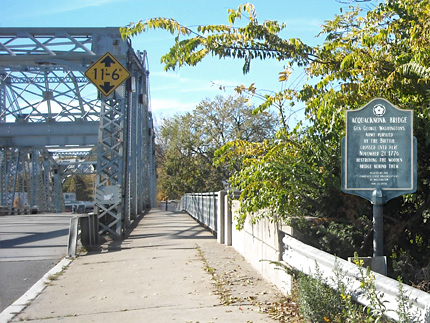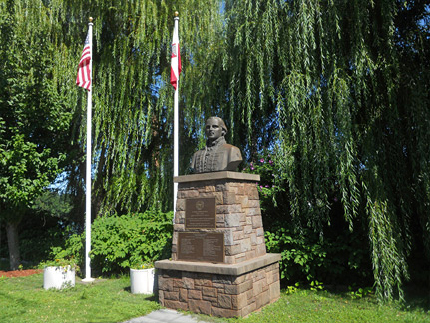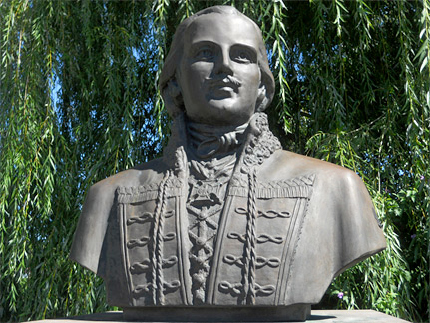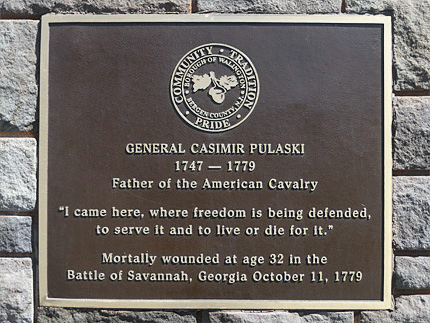



Acquackanonk Bridge
Corner of Main St. and Passaic St.
Map / Directions to the Acquakanonk Bridge
Map / Directions to all Wallington Revolutionary War Sites
On the night of November 19-20, 1776, 5000 British and Hessian forces under General Cornwallis crossed over the Hudson River, disembarking about six miles north of Fort Lee at Lower Closter Landing, causing the American troops to abandon their encampment at Fort Lee. This began a twelve-day retreat across New Jersey. On November 21, General Washington and his retreating Continental Army reached this site on the Passaic River, where they crossed over the wooden Acquackanonk Bridge. At that time, it was the only bridge in the area to cross the Passaic River. To slow the British forces who were pursuing them, they destroyed the bridge behind them. [1] (See the Fort Lee page of this website for a detailed description of the events surrounding Fort Lee and the evacuation and retreat.)
After the pursuing British arrived and found that the bridge had been destroyed, they located a spot three miles away in what is now Garfield where the river could be forded. (A ford is the term for a shallow spot in a river where it can be crossed on foot or horseback.) However, the river was running high due to heavy rains, so they decided to wait several days for the water level to go down before finally crossing on November 27. [2]
The Continental Army continued its retreat across New Jersey. They arrived on December 2 in Trenton, from where they spent five days moving all the troops and supplies across the Delaware River into Pennsylvania. [3]
This marker, which stands yards from the modern bridge here, commemorates the site. A small park along the river, next to the bridge, is called Liberty Crossing Park in honor of the November 21, 1776 crossing. It was dedicated October 20, 2007. [4] Note that the Passaic page of this website has additional listings related to this crossing.




General Casimir Pulaski Monument
Main Ave. near Locust St.
Map / Directions to the Pulaski Monument
Map / Directions to all Wallington Revolutionary War Sites
General Casimir Pulaski was born on March 6, 1745 in Warsaw, Poland. In 1777, he came to America to fight on the American side in the Revolutionary War. He commanded a group of cavalry which was formed in 1778 [5] known as Pulaski's Legion, and he is remembered as the "Father of American Cavalry." He died on October 11, 1779, from wounds suffered at the Battle of Savannah, Georgia.
The statue was sculpted by Mieczyslaw "Karol" Partyka ((1958-2009), a Polish-born sculptor who immigrated to New York in 1989. The monument was dedicated October 4, 2002. [6]
There are three other monuments honoring General Pulaski in New Jersey: one in Garfield, one in Paterson, and one in Pennsauken. In addition to these, there is a sidewalk plaque in North Arlington honoring Pulaski, and the Pulaski Skyway is named for him.
In 2009, Pulaski was made an Honorary Citizen of the United States [7]. Honorary Citizenship has rarely been granted; only eight people in the entire history of the United States have received it. Two of the others who have received Honorary Citizenship were also European officers who fought for the American side in the Revolutionary War: Marquis Lafayette of France and Bernardo de Gálvez of Spain. [8]

1. ^ For more information and accompanying source notes about the landing at Lower Closter Landing see the Alpine page of this website.
For a detailed description of the events connected with Fort Lee and the retreat, see the Fort Lee page.2. ^ William Winfield Scott, History of Passaic and its Environs, Volume II (New York Lewis: Historical Publishing Company Inc 1922) Page 744-748
Available to be read at Google Books here.▸ See the Post Ford entry on the Garfield page of this website for more information and accompanying source notes.
3. ^ George Washington letters from December 2 - December 8, 1776, reprinted in:
George Washington; Edited by Jared Sparks, The Writings of George Washington Volume 4 (Boston: Russel, Odiorne and Metcalf; and Hilliard, Gray, and Co., 1834) pages 200 - 206 Available to be read at Google Books here
• In his letter to the President of Congress marked "Head-Quarters, Trenton, 3 December, 1776," Washington wrote, "I arrived here myself yesterday morning, with the main body of the army..."
• In his letter to the President of Congress marked "Mr. Berkeley's Summer-Seat, 8 December, 1776," Washington wrote, "The retreat was accordingly made, and since to this [Pennsylvania] side of the river."
▸ "Mr. Berkeley's Summer-Seat" refers to the home of Thomas Barclay in Morrisville, PA, which Washington used as his headquarters from December 8-14, 1776. The house still stands and is open to the public for tours. For more information, see the Historic Summerseat website.• See also:
David Hackett Fischer, Washington's Crossing (New York: Oxford University Press, 2004) Page 1324. ^ October 20, 2007 date a plaque in Liberty Crossing Park
• A gallery of photos from the 2007 dedication ceremony can be seen on the Borough of Wallington NJ website here.
5. ^ Continental Congress, Saturday, March 28, 1778:
Roscoe R. Hill, Editor, Journals of the Continental Congress, 1774-1789, Volume X. January 1 - May 1, 1778 (Washington D.C. : Government Printing Office, 1908) page 290
Available to be read at the Internet Archive here
6. ^ Sculptor credit and dedication date information from bottom plaque on the front of the monument.
For more about the sculptor, see the following articles:
• Irving Dejohn and Jonathan Lemire, "Polish-born Brooklyn Sculptor Karol Washes up on Nearby Beach After Working on Boat in Storm," New York Daily News, July 28, 2009
• "A Retrospective Exhibition of Mieczyslaw "Karol" Partyka (1958-2009)," Consulate General of the Republic of Poland in New York; June 10, 20107. ^ Congressional Record: Senate: Vol. 155, Part 5 (Washington D.C. : Government Printing Office, 2009) pages 6153 - 6154
Available to be read at Google Books here8. ^ The other five people granted Honorary United States Citizenship are: Winston Churchill, Raoul Wallenberg, William and Hannah Callowhill Penn, and Mother Theresa. Only Churchill and Mother Theresa received the Honorary Citizenship while they were alive. All others received it posthumously.
See the document:
U.S. Department of State Foreign Affairs Manual Volume 7 – Consular Affairs / HONORARY CITIZENSHIP, which is available to be read on the U.S. State Department website here
▸ Note that Pulaski and de Gálvez are not listed in this document, because it was published in 2008, before either had been granted the honor.
• Pulaski was granted Honorary Citizenship in 2009 (See Source Note 7)
• Bernardo de Gálvez was granted Honorary Citizenship in 2014 (See H.J.Res.105 - Conferring honorary citizenship of the United States on Bernardo de Gálvez at the Library of Congress website here)